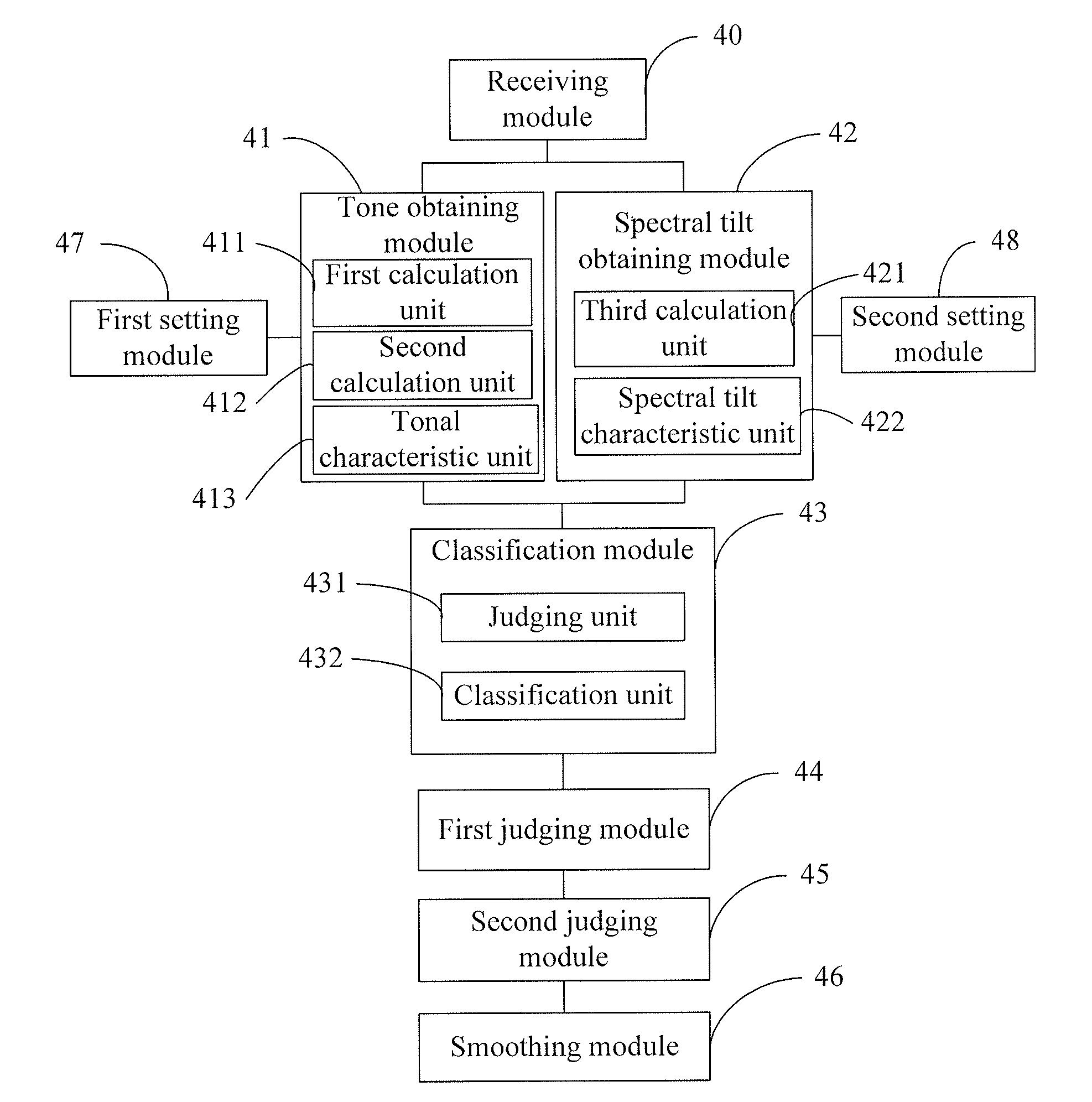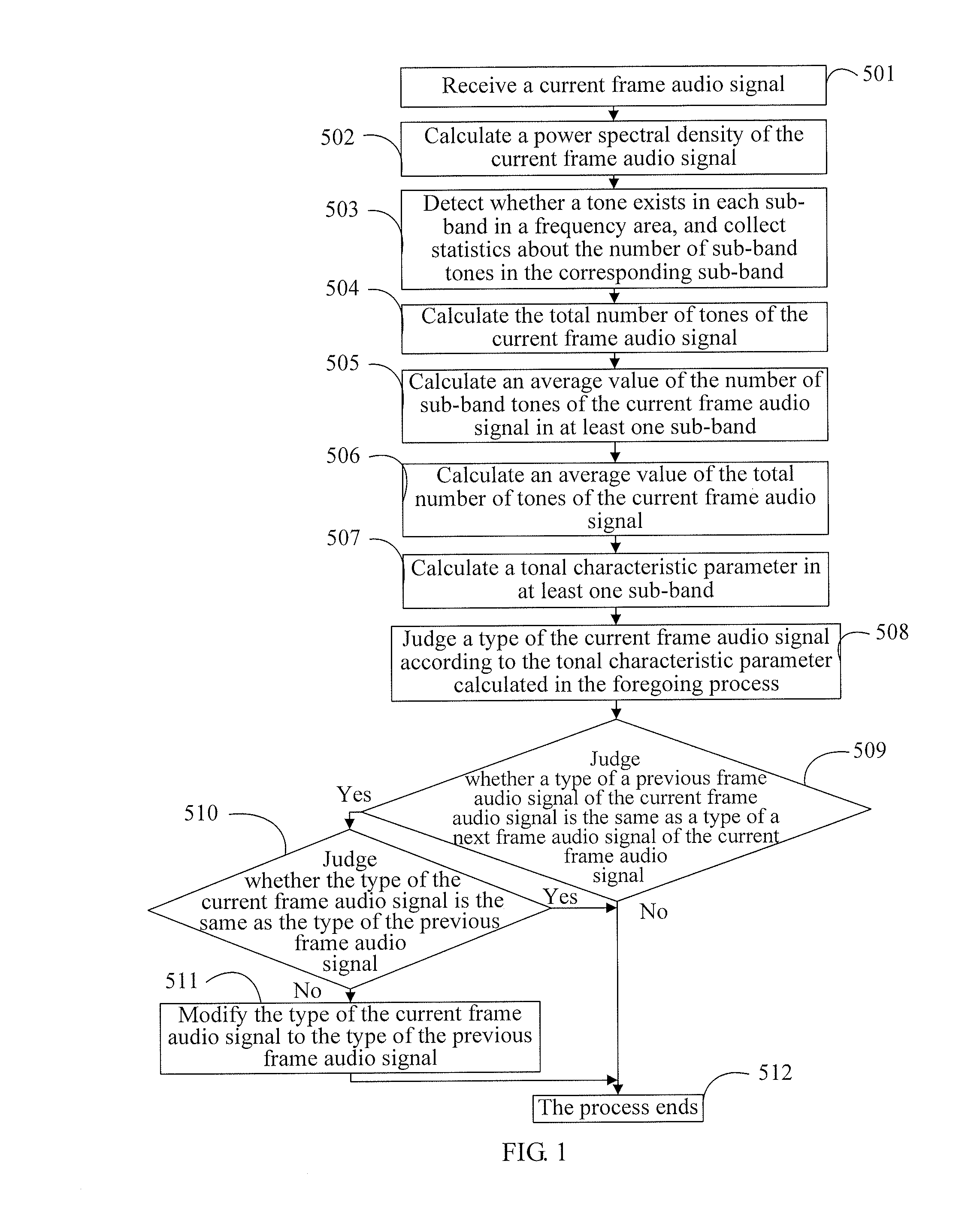Method and device for audio signal classification using tonal characteristic parameters and spectral tilt characteristic parameters
a technology of tonal characteristic parameters and characteristic parameters, applied in the field of communication technologies, can solve the problems of poor effect on encoding music-type audio signals, unsatisfactory effect on encoding voice-type audio signals under the mid-to-low bit rate, and high complexity of classification, so as to reduce the complexity of audio signal classification, reduce the amount of calculation required, and improve the effect of audio signal classification
- Summary
- Abstract
- Description
- Claims
- Application Information
AI Technical Summary
Benefits of technology
Problems solved by technology
Method used
Image
Examples
embodiment 1
[0030]This embodiment provides a method for audio signal classification. As shown in FIG. 1, the method includes the following steps.
[0031]Step 501: Receive a current frame audio signal, where the audio signal is an audio signal to be classified.
[0032]Specifically, it is assumed that a sampling frequency is 48 kHz, and a frame length N=1024 sample points, and the received current frame audio signal is a kth frame audio signal.
[0033]A process of calculating a tonal characteristic parameter of the current frame audio signal is described below.
[0034]Step 502: Calculate a power spectral density of the current frame audio signal.
[0035]Specifically, windowing processing of adding a Hanning window is performed on time-domain data of the kth frame audio signal.
[0036]Calculation may be performed through the following Hanning window formula:
[0037]h(l)=83·0.5·[1-cos(2π·lN)],0≤l≤N-1(1)
[0038]where N represents a frame length, h(l) represents Hanning window data of a first sample point of the ...
embodiment 2
[0095]This embodiment discloses a method for audio signal classification. As shown in FIG. 2, the method includes:
[0096]Step 101: Receive a current frame audio signal, where the audio signal is an audio signal to be classified.
[0097]Step 102: Obtain a tonal characteristic parameter of the current frame audio signal, where the tonal characteristic parameter of the current frame audio signal is in at least one sub-band.
[0098]Generally, a frequency area is divided into four frequency sub-bands. In each sub-band, the current frame audio signal may obtain a corresponding tonal characteristic parameter. Certainly, according to design requirements, a tonal characteristic parameter of the current frame audio signal in one or two of the sub-bands may be obtained.
[0099]Step 103: Obtain a spectral tilt characteristic parameter of the current frame audio signal.
[0100]In this embodiment, an execution sequence of step 102 and step 103 is not restricted, and step 102 and step 103 may even be execu...
embodiment 3
[0103]This embodiment provides a method for audio signal classification. As shown in FIGS. 3A and 3B, the method includes the following steps.
[0104]Step 201: Receive a current frame audio signal, where the audio signal is an audio signal to be classified.
[0105]Specifically, it is assumed that a sampling frequency is 48 kHz, and a frame length N=1024 sample points, and the received current frame audio signal is a kth frame audio signal.
[0106]A process of calculating a tonal characteristic parameter of the current frame audio signal is described below.
[0107]Step 202: Calculate a power spectral density of the current frame audio signal.
[0108]Specifically, windowing processing of adding a Hanning window is performed on time-domain data of the kth frame audio signal.
[0109]Calculation may be performed through the following Hanning window formula:
[0110]h(l)=83·0.5·[1-cos(2π·lN)],0≤l≤N-1(1)
[0111]where N represents a frame length, h(l) represents Hanning window data of a first sample poin...
PUM
 Login to View More
Login to View More Abstract
Description
Claims
Application Information
 Login to View More
Login to View More - R&D
- Intellectual Property
- Life Sciences
- Materials
- Tech Scout
- Unparalleled Data Quality
- Higher Quality Content
- 60% Fewer Hallucinations
Browse by: Latest US Patents, China's latest patents, Technical Efficacy Thesaurus, Application Domain, Technology Topic, Popular Technical Reports.
© 2025 PatSnap. All rights reserved.Legal|Privacy policy|Modern Slavery Act Transparency Statement|Sitemap|About US| Contact US: help@patsnap.com



